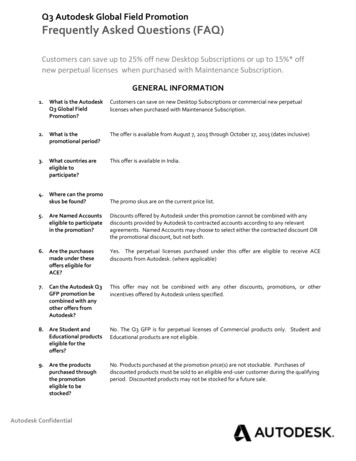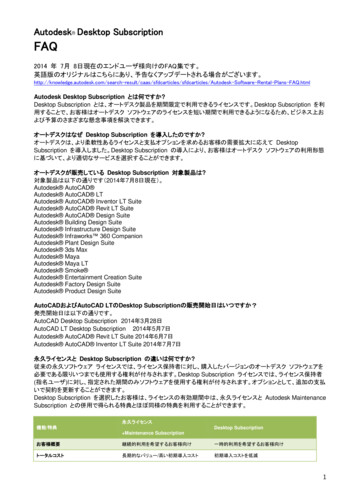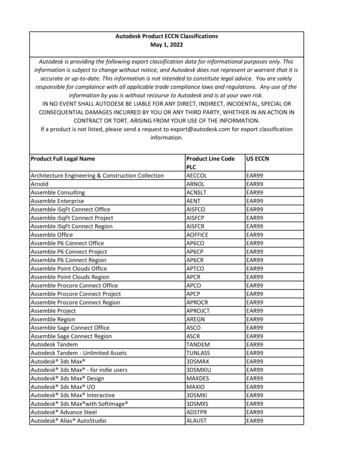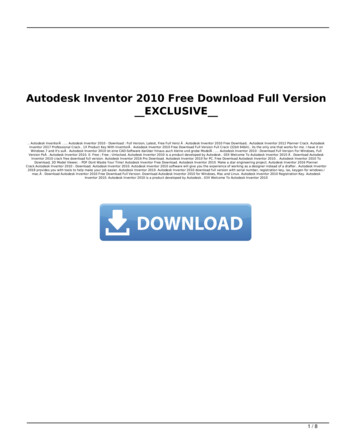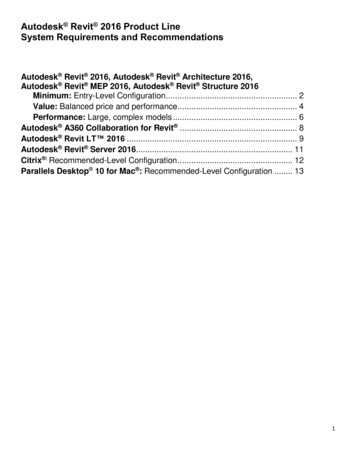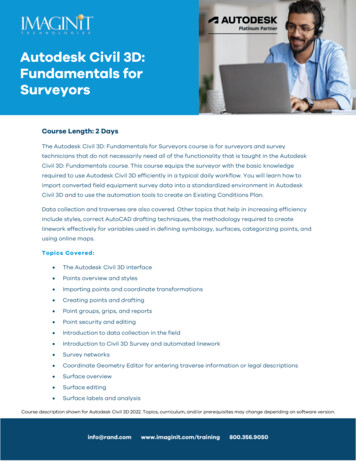
Transcription
Autodesk Civil 3D:Fundamentals forSurveyorsCourse Length: 2 DaysThe Autodesk Civil 3D: Fundamentals for Surveyors course is for surveyors and surveytechnicians that do not necessarily need all of the functionality that is taught in the AutodeskCivil 3D: Fundamentals course. This course equips the surveyor with the basic knowledgerequired to use Autodesk Civil 3D efficiently in a typical daily workflow. You will learn how toimport converted field equipment survey data into a standardized environment in AutodeskCivil 3D and to use the automation tools to create an Existing Conditions Plan.Data collection and traverses are also covered. Other topics that help in increasing efficiencyinclude styles, correct AutoCAD drafting techniques, the methodology required to createlinework effectively for variables used in defining symbology, surfaces, categorizing points, andusing online maps.Topics Covered: The Autodesk Civil 3D interface Points overview and styles Importing points and coordinate transformations Creating points and drafting Point groups, grips, and reports Point security and editing Introduction to data collection in the field Introduction to Civil 3D Survey and automated linework Survey networks Coordinate Geometry Editor for entering traverse information or legal descriptions Surface overview Surface editing Surface labels and analysisCourse description shown for Autodesk Civil 3D 2022. Topics, curriculum, and/or prerequisites may change depending on software 356.9050
Prerequisites:Experience with AutoCAD or AutoCAD-based products and a sound understanding andknowledge of civil engineering terminology.Learning Guide ContentsChapter 1: The Autodesk Civil 3D Interface 1.1 Product Overview 1.2 Autodesk Civil 3D Workspaces 1.3 Autodesk Civil 3D User Interface 1.4 Autodesk Civil 3D Toolspace 1.5 Autodesk Civil 3D Panorama 1.6 Autodesk Civil 3D Templates, Settings, and StylesChapter 2: Survey Setup 2.1 Survey Workflow Overview 2.2 Collecting Field Data 2.3 Introduction to the Survey Toolspace 2.4 Survey User Settings vs. Drawing Template 2.5 Templates 2.6 Survey Figures 2.7 Points Overview 2.8 Description Key Sets 2.9 The Survey DatabaseChapter 3: Entering Linework 3.1 Survey Workflow Overview 3.2 Lines and Curves 3.3 Online Maps Service 3.4 Traverse Editor 3.5 Traverse AdjustmentCourse description shown for Autodesk Civil 3D 2022. Topics, curriculum, and/or prerequisites may change depending on software 356.9050
Chapter 4: Field Book Files 4.1 Survey Networks 4.2 Importing a Field Book 4.3 Traverse Basics 4.4 Defining a Traverse 4.5 Multiple Network Surveys 4.6 Working with FiguresChapter 5: Points with Connective Codes 5.1 Field Codes 5.2 Survey Data - Figures 5.3 Figure Prefix Database 5.4 Survey Data - Line Code 5.5 Adjusting Figures 5.6 Translating a Survey DatabaseChapter 6: Points 6.1 Point Settings 6.2 Creating COGO Points 6.3 Transparent Commands 6.4 Importing and Exporting Points 6.5 Point Groups 6.6 Reviewing and Editing Points 6.7 Locking/Unlocking Points 6.8 Point Reports 6.9 Filtering a Survey DatabaseCourse description shown for Autodesk Civil 3D 2022. Topics, curriculum, and/or prerequisites may change depending on software 356.9050
Chapter 7: Surfaces 7.1 Surface Process 7.2 Surface Properties 7.3 Surface Data 7.4 Breaklines and Boundaries 7.5 Surface Editing 7.6 Surface Analysis Tools 7.7 Surface Labels 7.8 Surface Analysis DisplayChapter 8: Field to Finish 8.1 Field to Finish Overview 8.2 Fieldwork Standards 8.3 Civil 3D Settings 8.4 Survey Toolspace 8.5 Drawing Production 8.6 Project Workflow 8.7 ShareAppendix A: Additional Tools A.1 Least Squares A.2 Creating a Least Squares Input File A.3 Querying Survey Database Points with the Survey Command WindowAppendix B: Connecting to Geospatial Data B.1 Introduction to the Planning and Analysis Workspace B.2 Coordinate Systems B.3 Geospatial Data Connection B.4 Create a Surface from GIS DataAppendix C: Additional Surface Tools C.1 Surface Volume Calculations C.2 Point Cloud Surface ExtractionCourse description shown for Autodesk Civil 3D 2022. Topics, curriculum, and/or prerequisites may change depending on software 356.9050
Cancellation PolicyThe following cancellation policy shall apply to all training engagements, LIVE Online,Consulting Services and Dedicated/Custom Training: Company reserves the right to reschedule or cancel the date, time and location of itsclass at any time. In the event that a Training Class is cancelled by Company, Customeris entitled to a full refund. Company shall not be responsible for any other loss incurredby Customer as a result of a cancellation or reschedule. For Customer cancellations when written notice is received (i) at least ten (10) businessdays in advance of the class, the Customer is entitled to a full refund of its payment orreschedule enrollment, (ii) less than ten (10) business days, Customer shall not beentitled to a refund, but shall receive a class credit to be used within three (3) months ofthe date of the original class. Student substitutions are acceptable with at least two (2) days prior notice to the class,provided substitution meets course prerequisites and is approved by Company’sTraining Coordinator (trainingcoordinator@rand.com) For all Training orders, cancellation notices must be submitted totrainingcoordinator@rand.com. Company is not responsible for any error in the deliveryof the email notice. In the event of any reschedule of Consulting Services and/orDedicated/Custom Training by Customer, Company will invoice Customer for all noncancellable travel expenses.To request more information or to see training locations, visit www.imaginit.com/contact-us.Course description shown for Autodesk Civil 3D 2022. Topics, curriculum, and/or prerequisites may change depending on software 356.9050
The Autodesk Civil 3D: Fundamentals for Surveyors course is for surveyors and survey technicians that do not necessarily need all of the functionality that is taught in the Autodesk Civil 3D: Fundamentals course. This course equips the surveyor with the basic knowledge required to use Autodesk Civil 3D efficiently in a typical daily workflow.

